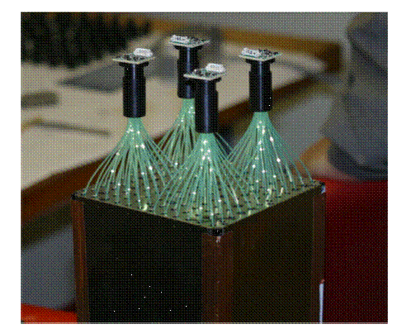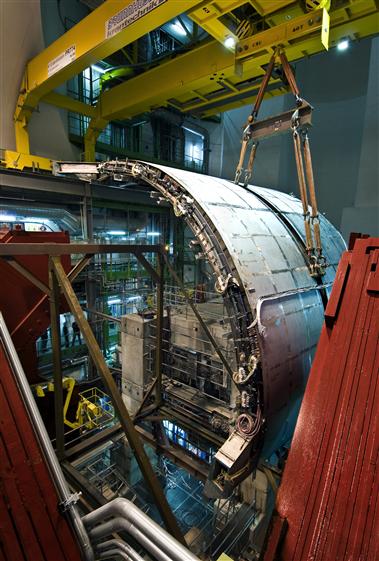
The Electro Magnetic Calorimeter (EMCal) enhances the capabilities of ALICE to measure highly energetic photons, electrons, neutral pions, and jets of particles, and the correlations between them. The EMCal is a shashlik-type lead-scintillator sampling calorimeter comprising 4416 individual modules that are grouped into twenty Super Modules (SM). Each of the modules is composed by 4 optically isolated towers, resulting to 17664 individual towers in total. The optical readout of each tower is provided using wavelength shifting fibers coupled to an Avalanche Photo Diode (APD).
The overall design of the calorimeter is heavily influenced by its integration within the ALICE setup and SM’s of 3 different sizes are used: full-, 2/3- and 1/3- size. Each full-size SM is assembled from 1224= 288 modules. Each 2/3-size SM is assembled from 1216=192 modules, and each one-third size SM is assembled from 424=96 modules.
The EMCal is made of ten full-size SMs and two 1/3-size SMs covering 0.7 unit in pseudo-rapidity and 80 to 187 in azimuth. The addendum of EMCal, so called DCal, is made of six 2/3-size SMs and two 1/3-size SMs with acceptance: 0.22 < |eta| < 0.7, 260 < phi < 320 and |eta| < 0.7, 320 < phi < 327. The EMCal and the DCal are placed in two independent regions in azimuth, as illustrated in Figure 2. The SMs are located 4.5 m in radial distance from the beamline, inserted into support frames situated between the Time-of-Flight detector and the ALICE L3 magnet. The weight of a single full-size SM is 7.7 tons, and the total weight of all 20 SMs is 120 tons.
The front face dimensions of the towers are ~66 cm2 resulting in individual tower acceptance of ∆η∆ 0.0140.014 at η=0. The towers are arranged within the SMs such that each tower is approximately projective in η and to the interaction vertex. The towers are operated at ~25C ambient temperature with a nominal APD gain of 30, allowing to achieve a 14-bit effective dynamic energy range from 16 MeV to 250 GeV per tower. The signal time is also measured per tower with few ns precision.
Both EMCal and DCal are also equipped with triggering systems. The signals of 44 groups of adjacent towers are summed up and a peak finding algorithm is used to find a signal peak, providing L0- and L1- level triggers to the ALICE Central Trigger Processor allowing to select online high-energy objects like photons and electrons. The signals from 1616 and 3232 adjacent towers are also processed and a L1-level trigger is provided for detecting wide objects as jets. In order to reduce the bias due to multiplicity fluctuations in heavy-ion collisions, there is direct communication between EMCal and DCal L1 triggering units for considering the underlying event background in the online L1 trigger decision.


